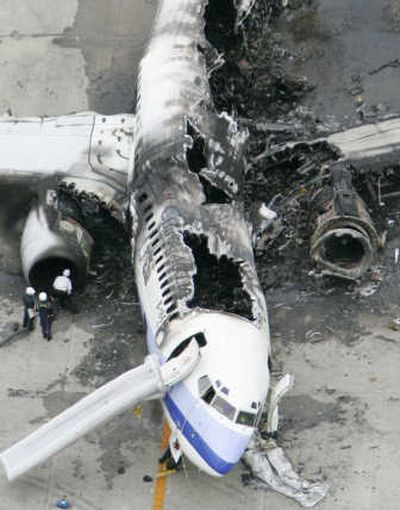Taiwan grounds 737 fleet after blast

NAHA, Japan – Taiwan grounded its fleet of Boeing 737-800 jetliners after a China Airlines plane exploded in a fireball Monday on the tarmac in Okinawa, and officials said a fuel leak may be to blame. All 165 passengers and crew scrambled down emergency chutes or jumped from cockpit windows – some just seconds before the blast.
Passengers described a normal landing after Flight CI-120 landed on the resort island of Okinawa from the Taiwanese capital of Taipei. But as the jet came to a stop near the terminal, they said that the left engine began smoking, followed by the right one.
Okinawa Airport traffic controllers had received no report from the pilot indicating anything was wrong as the plane came in to land and even as it stopped near the terminal to unload passengers, said Japanese Transport Ministry official Akihiko Tamura.
When the smoke started billowing outside the plane, the cabin crew already was standing by the doors, said a passenger who gave his surname as Tsang and identified himself as a guide for Taipei’s Southeast Tours.
“The passengers saw the smoke first and they began to yell and demand that the doors be opened,” he said.
Tamura said the fire started “when the left engine exploded a minute after the aircraft entered the parking spot.”
Inside the plane, passengers recalled a scene of panic.
“When the smoke started, people were just pushing and shoving each other,” said an unidentified female Taiwanese passenger. “It was total chaos.”
The main explosion, which engulfed the center of the aircraft in flames, occurred after the passengers slid down the emergency chutes at the front and rear of the plane.
Screams erupted as passengers raced across the tarmac to get away from the burning plane, and emergency personnel moved in to fight the fire.
A figure believed to be the pilot hung onto the cockpit window for several seconds before dropping to the tarmac and sprinting away from the exploding plane.
There were no serious injuries among the 157 passengers, including two infants, and crew of eight, Taiwan-based China Airlines said.
A Taiwanese woman said she was stricken with fear as she slid down the chute.
“I was running and crying, running and crying,” said the woman, who declined to give her name.
Another passenger who gave only his surname, Chen, said he started running the moment he slid off the plane. “I ran so hard my sock tore,” he said. “I think I got my life back.”
Tsang said the evacuation took no more than 90 seconds.
“About 30 seconds after I slid down the chute and began to run toward the terminal, I heard two big explosions,” he said. “I had no idea it would be this serious.”
Video from Japanese broadcaster NHK showed a lone firefighter trying to douse the fire immediately after the explosion. But the plane was quickly rocked by two more explosions, which brought the fuselage crashing to the tarmac.
Initial reports from ground personnel said a fuel leak from the right engine could have led to the explosions, according to another Japanese Transport Ministry official, Fumio Yasukawa.
The fire was extinguished after about an hour, leaving the aircraft sagging on its side, charred in the middle, with part of its roof burned away.
Taiwan’s Civil Aeronautics Administration head Chang Kuo-cheng said authorities ordered China Airlines and its subsidiary Mandarin Airlines to ground their 13 other Boeing 737-800s pending an inspection.
Japanese aviation authorities also ordered an emergency inspection of all Boeing 737-800 planes owned by Japanese carriers, as well as some 737-700 models that have similar engines.
As of July 31, there were about 1,220 737-800s flying worldwide, with more than 1,000 of the aircraft on order.
Boeing has delivered more than 5,400 737s since the plane entered commercial service in 1968. Boeing spokesman Jim Proulx said he could not say exactly how many of the single-aisle jets are still flying, but noted that a “significant” number of older models have been retired.